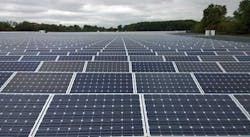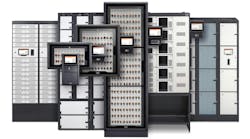SAN DIEGO, Calif. – The data center industry has emerged as a leading player in the market for renewable energy, as cloud computing platforms shift to solar and wind to power their servers. In 2016, data center providers signed contracts for more than 1.2 gigawatts of renewable power, marking a dramatic turnaround from earlier headlines critiquing the industry’s dependence upon “dirty coal.”
“We’ve been incredibly good at improving as an industry,” said KC Mares of Megwatt Consulting, a leading advocate for sustainable computing. “We have become part of the solution. We’ve made our economy more energy efficient.”
Mares and other thought leaders outlined the industry’s progress last week at the Green Data Center Conference in San Diego, noting that renewables are becoming cheaper and easier to acquire.
Greening the Bottom Line
Cloud computing’s emergence as a force for sustainability may also make the bottom line greener. As more customers seek renewable energy to fulfill mandates for corporate social responsibility, shifting workloads to the cloud presents an attractive way to meet those goals.
“There’s a revolution happening right now,” said Brett Illers, the Senior Program Manager for Sustainability at Yahoo. “We have an obligation to use our purchasing power to push utilities on green power.”
This aligns with the vision of Greenpeace, which has offered sharp critiques of energy practices at data centers. This year the environmental group has shifted gears, citing meaningful improvement in the use of green energy by cloud computing platforms.
Many of these purchases by hyperscale data center providers have created new production of clean energy, as opposed to credits for use of clean energy from existing sources. This “additionality” is a key strategic priority for Google and several other large cloud customers, who want their investments to support a longer-term shift away from fossil fuel. It’s a virtuous cycle, as this increased generation improves the economics of wind and solar power, making the energy math work for price-sensitive cloud builders.
“The data center industry is the largest driver for new renewables,” said Jack Pouchet, Vice President of Market Development at Vertiv. “There’s a reason for that. The secret is that it makes business sense. No one will do it if it doesn’t make economic sense.”
Major Players in PPA Market
The data center industry’s growing clout in the market for wind and solar energy is best illustrated in the surge of power purchase agreements (PPAs), “utility scale” bulk purchases that help create a market for renewable generation.
“2015 was a really big year for corporate PPAs,” said Kevin Gildea, the Executive Director of Development at Nextera Energy, a major provider of renewable energy. Gildea said U.S. corporate purchases of PPAs for renewable energy surged to 2.5 gigawatts in 2015, up from 300 megawatts (MW) a year earlier. Colocation providers Equinix (225 MW) and Switch (180 MW) were among the largest data center purchasers of PPAs.
In 2016, data center providers signed multiple large deals for renewable PPAs. These included:
- Google: 425 MW
- Amazon Web Services: 416 MW
- Microsoft: 237 MW
- Digital Realty: 88 MW
- Iron Mountain: 52 MW
- Salesforce: 24 MW
Gildea noted that data center load is expected to grow seven percent a year through 2020. “For a company like ours, that’s an opportunity,” he told the conference. “There are a lot of renewable energy producers who want to talk with you.”
Renewable energy accounted for 7 percent of all power in the U.S. in 2015, including hydro-electric, wind, solar and geothermal power. But that number rose as high as 16 percent of new generation in the first half of 2016. As more renewables become available, prices are improving.
The cost of electricity in the U.S. ranges from 2.5 cents per kilowatt hour (kWh) up to 25 cents, with an average price of around 11 centers per kWh. In Nevada, Apple and Switch have been able to procure solar energy for just under 4 cents per kWh, an extremely competitive rate. Wind power is avalable for as low as 2.5 cents per kWh, Mares said.
KC Mares of Megawatt Consulting speaks at the Green Data Center Conference in San Diego. (Photo: Rich Miller)
“If you’re a large enough buyer, you can get really great forms of electricity really cheap,” said Mares. “You don’t need 100 megawatts to do this, either.”
The price of electricity is the single largest cost factor in the operation of a data center over 10 years, said Mares, who has done site selection and sustainability work for Google, Yahoo, Apple and many others. That’s why hyperscale data centers are located outside of major cities, in regions offering cheap power and abundant land.
Mares noted that technology companies can use innovative approaches to the energy markets. “Tech companies can provide financing cheaper than banks, because they have so much cash,” Mares said.
Energy Security Through Renewables
Pouchet said on-site renewables can also reduce a data center’s reliance upon the grid, making it more resilient. “Energy security is a key reason why people are deploying renewables. You’re controlling your own destiny. You’re managing the dynamics of the energy markets.”
Pouchet believes that more data centers should be located near generation sources for renewable energy.
“We have to move the data centers closer to the energy,” said Pouchet. “Transmission and distribution are the weakest links. If you take transmission and distribution out of the equation, you’ve removed the source of most of the outages. The generation source is usually very robust and secure. The closer you can move your data center to the energy source, the better off you are.”
Although the data center industry has made major advances in its use of renewable energy, most of that progress is concentrated among hyperscale players who have the scale and staff support to broker large deals. Green energy procurement has seen limited adoption in multi-tenant data centers, with only the largest providers (including Switch, Equinix and Digital Realty) able to participate.
For one thing, most PPAs require a 20-year contract. “We want certainty,’ said Gildea of Nextera. “Renewable energy development is expensive. As spot prices surge, long term agreements provide savings.”
Contract Complexity An Issue
Price swings can create unpredictability in large power deals, particularly for intermittent sources like wind energy. Many wind generators receive federal Production Tax Credits, which incentivize them to continue generating during price fluctuations. That has implications for the ERCOT grid, which includes many large wind farms in West Texas that create a power surplus during a thunderstorm.
“They’ll call data centers and offer energy, so rates go down,” said Pouchet.
This gets tricky with a Contract for Difference, a price management tool used in energy markets where the financial terms are based on the gap between current and future prices. When prices move higher, the seller pays the difference to the buyer. But when prices plunge, the buyer is on the hook for the price difference.
This became an issue for Yahoo, which was able to use hydro power from local utilities to support its innovative Computing Coop campuses in Quincy, Washington and Lockport, N.Y. Yahoo used a Contract for Difference for renewable power to support its data center in LaVista, Nebraska. This created financial uncertainty, according to Illers.
Brett Illers, Yahoo’s Senior Program Manager for Sustainability, discusses the company’s power sourcing at the Green Data Center Conference in San Diego. (Photo: Rich Miller)
Yahoo sought to work out a new agreement to procure renewable energy through a “sleeve” agreement, which allows a company to buy energy from a renewable source and pay the local utility for transmission and distribution. These agreements, also known as direct access, have been used by Infomart to offer renewable power to data center customers in San Jose and Portland.
After months of discussions with Nebraska officials and utilities without results, Illers was frustrated. “We told them ‘You will not get any more data centers without 100 percent clean power,'” he said. “You need to figure out a way to do this, and move on it now, or you’ll keep losing data center deals to Iowa and ERCOT.”
Yahoo eventually worked a deal with the Omaha Public Power District. “They basically charge you an administrative fee and a demand charge, and you go out and purchase your power,” said Illers. But the deal required the involvement of a bank trading desk to help hedge Yahoo’s pricing.
Building Upon Efficiency Gains
The shift toward renewable energy marks the second phase of the data center industry’s effort to address its massive use of energy. The first phase focused on energy efficiency, applying innovation in data center design to slash consumption of grid energy. Last June the U.S. government reported America’s data centers have dramatically improved their energy efficiency, resulting in a small increase in industry electricity use during a period of explosive growth for cloud computing and online services.
But efficiency was not enough for Greenpeace, which launched public campaigns to shame Facebook, Apple and Amazon for the use of “dirty coal” to power their data centers. The environmental group called on data center operators, some of the largest energy users, to pressure electric utilities to offer more energy from renewable sources. That has begun to happen at scale, and Greenpeace has taken note.
“We have witnessed leaders such as Google, Apple, Facebook, eBay, and now Switch using their influence to push vendors, utilities, and governments to create access to renewable energy where previously there was none,” the group said in its most recent Clicking Clean report. [clickToTweet tweet=”Jack Pouchet: Greenpeace is one of the best things that ever happened to the data center industry.” quote=”Jack Pouchet: Greenpeace is one of the best things that ever happened to the data center industry.”]
The industry has been divided about Greenpeace, with some hailing it as a force for accountability, while others taking issue with the group’s targeting of progressive companies for public shaming.
At last week’s conference, the verdict was that Greenpeace played a constructive role.
“Greenpeace moved the needle more than anyone,” said Illers.
Pouchet shared that opinion. “Greenpeace is one of the best things that ever happened,” he said. “It made us take a look at our industry.
“There’s been a lot of pressure on this industry for more than a decade,” Pouchet added. ” We’re the fastest growing sector. We were once the poster child for everything that was bad. Innovators came along, and the industry responded.”
About the Author



